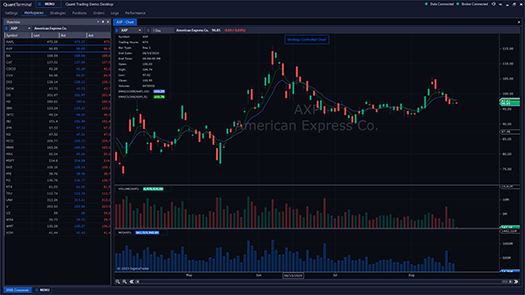An automated trading platform consists of several elements. You should decide which markets you want to trade, create a feature to identify trading logic, and develop a solid strategy to implement this logic to buy or sell the stock. A platform should be able to decide when to enter and exit a trade and optimize via backtesting.
What Is Quantitative Trading?
Quantitative trading is a sort of market strategy that relies on mathematical and statistical models to analyze patterns and trends in stocks’ movement and behaviour to choose undervalued stocks at the ideal time and make a profitable trade.
This model is entirely driven by quantitative analysis, which is where the strategy gets its name from. Quant trading also requires a lot of computation power, so large institutional investors and hedge funds have generally utilized it. Many retail investors are also using a modern quantitative trading strategy.
How Does Quantitative Trading Work?
Quantitative trading works by using a data-based model to determine the possibility of a specific outcome. It solely relies on statistical methods and an automated trading platform to do this.
Quantitative Vs. Algorithmic Trading
Algo traders use automated trading platforms to analyze chart patterns then open and close positions on their behalf. Quant traders use statistical methods to identify opportunities. While quantitative and algorithmic trading overlap each other, they’re separated techniques.
Here are a few crucial points to be considered:
- An algorithmic system will execute on your behalf, whereas some quant traders use models to identify opportunities and then open a position on their behalf.
- Algorithmic trading relies on more traditional technical analysis, whereas quantitative trading uses advanced mathematical methods.
- Algo trading uses chart analysis and data from exchanges to find a new position, and quant traders use different datasheets.
Quantitative Trading Example
The primary inputs for mathematical model building are price and volume. These sorts of methods have algorithmic and complex statistical models. The quantitative traders should be well versed with numerical tools such as moving average. They should take a solid strategy and build a mathematical model based on historical data. The model is then tested and evaluated. If the model is successful, the model is then used for real capital and market trading.
Let’s say Max runs an ABC firm. He utilizes an algorithmic system to select and pick stocks.
- The automated trading platform will scan more than 50 variables in five categories: value, momentum, earning, and volume to pick and select stocks.
- The system will put a value to each variable and max choose the one with the highest ratings.
Quantitative Trading System
Quant traders develop a system to identify new opportunities and then execute them as well. While every system is unique, they usually have specific components. Let’s take a look at each one.
Strategy
Before creating or developing any system, quants will look for a solid strategy that will work for them. This process includes devising a strategy, assessing whether the strategy is suitable with the current set of methods, and gathering any data required to test the strategy.
A retail investor will need to decide their capital investment and how other transactional costs would affect his decision. There are various sources where trading results and transactional costs are available.
Backtesting
Backtesting involves applying the strategy to historical data to get an idea of how it will perform on live markets. Quants will use this component to optimize their system or automated trading platform to iron out any kinks.
It is an essential part of any automated trading strategy, but there is no guarantee of profit when the model is live. Several backtesting factors, including the availability of historical data, transaction cost, and deciding a backtesting method, can affect a fully backtesting strategy.
Execution
Every system contains a manual or an automated execution component. It usually uses an API to open and close the position as soon as possible without any human input. The ideal way will be to automate the execution mechanism of one trade. It will help you in focusing on research and run strategies of higher frequency.
Risk Management
Any sort of trading requires risk management, and quant is no different. It includes biases like brokerage risk, investment risk, and technology risk.
Quantitative trading has technology as its cornerstone. Many hedge funds and investment firms hire quant teams to analyze datasheets, find new opportunities, and then build a solid strategy around them. However, some retail traders use quantitative trading techniques. Thus, you will need exceptional mathematical knowledge to test and build your statistical model.
If you’re interested in automated trading but don’t know about the mathematical or coding side of quant, you can use some popular automated trading platforms to start your algorithmic trading.
